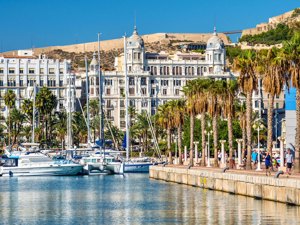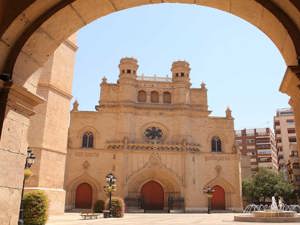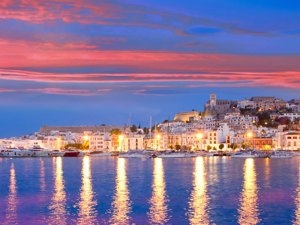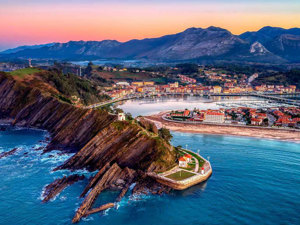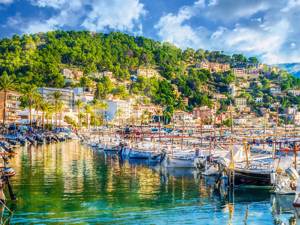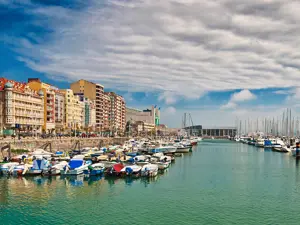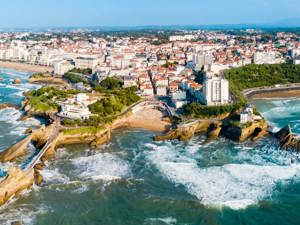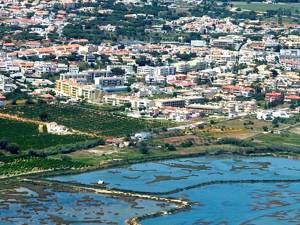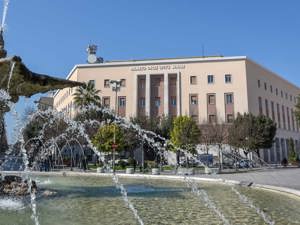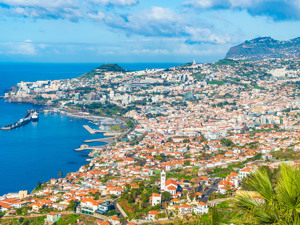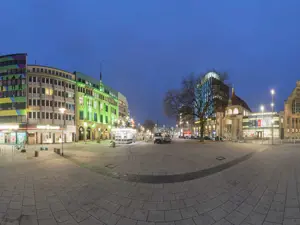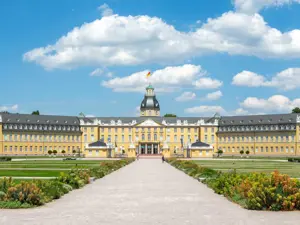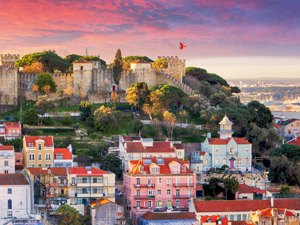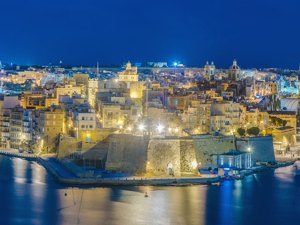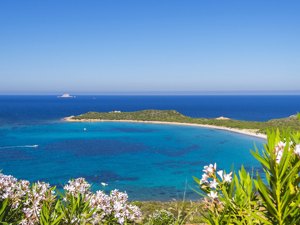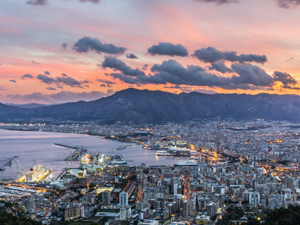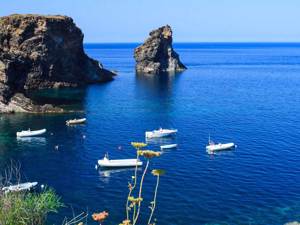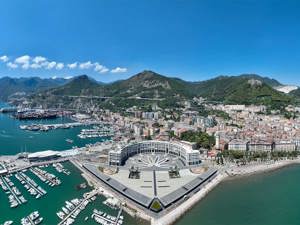The third Holy City of Christianity
Since the ninth century pilgrims from all over the world have travelled along the Camino (Way of St. James) on foot or on horseback, and in recent times even by bike. Arriving directly by plane eliminates the experience of adventure, but certainly not the feeling of spirituality and the striking atmosphere of the final destination.

Santiago de Compostela. Panoramic view on the Cathedral. Copyright © Sisterscom.com / Serjio74 / Shutterstock
The most notable aspect of this ancient city, the capital of Galicia, is its very rich monumental heritage.
The historic centre of Santiago de Compostela
The historic centre, which has been declared a UNESCO World Heritage site, is a succession of narrow streets, squares and granite buildings imbued with centuries of history, many dating back to the Middle Ages. Dominating everything is the Cathedral, an architectural gem with a majestic façade, which sits in Obradoiro Square.

Santiago de Compostela. Cathedral. Copyright © Sisterscom.com / Shutterstock
Built of granite stone and covered with slabs in the same material, the church, which houses the tomb of the apostle James, has three naves and is considered a characteristic Romanesque building. Pilgrim’s Mass is held at midday and during the service a botafumeiro, a giant thurible, is swung along the nave of the church.
To visit in Santiago de Compostela
- Museums that are well worth visiting include the Museo do Pobo Galego (Museum of the Galician People),
- The Galician Centre for Contemporary Art, two buildings that house works of inestimable artistic value,
- The symbolic building of the Faculty of History and Geography of Santiago University.

Santiago de Compostela. Cultural complex: the City of Culture of Galicia. Copyright © Sisterscom.com / faber1893 / Shutterstock
Parks and gardens in Santiago de Compostela
Parks and gardens are a dominant feature of Santiago, which has a million and a half square metres of public green areas, evident proof of the care given to the countryside and the environment. Nature not only surrounds Santiago de Compostela, but seems to get to the very heart of the city, which is set is a location without equal. Forests, mountains and valleys, impregnated with the scent of damp earth, give this place a charm of its own.

Santiago de Compostela. Alameda Park. Copyright © Sisterscom.com / Shutterstock
The squares around the cathedral play host to improvised shows by artists, musicians and, obviously, university musical groups. The main areas for nightlife in the city are the historic centre and the Ensanche area. In the historic centre, places tend to have more character and unusual decor - some are set in historic buildings, such as the stables and garages of old palaces. This area runs from Nova, Xelmírez, Conga, Acibechería, Entremuros streets and surrounding areas, up to Virxe da Cerca.
The path of Santiago de Compostela

The path to Santiago de Compostela. Copyright © Sisterscom.com / faber1893 / Shutterstock
Santiago de Compostela is one of the holy cities of Christianity after Jerusalem and Rome. Start the journey to the Sanctuary, where the tomb of Santiago the Greater, one of the apostles of Jesus, was found, means, since the Middle Ages, for all pilgrims, to embark on a symbolic journey towards salvation. There are more than 200,000 pilgrims who come to Santiago each year, in addition to Christians, there are people of other faiths, and even atheists, who embark on the journey. What unites them is the search for the true nature of man and their relationship with his soul.
The routes in Santiago de Compostela

The path to Santiago de Compostela.
Copyright © Sisterscom.com / Shutterstock
There are over 60 routes to reach Santiago de Compostela.
Among the most popular there are:
Among the most popular there are:
- Primitivo Way is 343 km long starting from Oviedo.
- French Way is 800 km long starting from Saint-Jean Pied de Port on the Pyrenees and it's divided into 25 km stages.
- Northern Way is 850 km long, starting from Irùn (French/Spanish border).
- Via della Plata is 1000 km long and starts from Seville.
- Portuguese Way is 760 km long and starts from Ponte de Lima in Portugal.
Gastronomic specialties of the cuisine of Santiago de Compostela
Gastronomy is one of the major attractions in Santiago de Compostela, and it is an important part of the city's way of life and identity. Places to eat range from traditional restaurants, inns and taverns, where you can enjoy wonderful local dishes made with fresh produce such as hot gallego (a local soup of vegetables and beans), to the churrasquerías which serve Galician beef and the marisquerías, shellfish restaurants. Don’t leave Santiago without tasting a good mariscada, a magnificent shellfish dish. To try is the Santiago cake made with almonds and wih the decoration of a cross.
Text by Federica Fusco
Updated by Alisè Vitri
Avion Tourism Magazine
Avion Tourism Magazine
Photos: Sisterscom.com, Shutterstock
Copyright © Sisterscom.com. All rights reserved
Copyright © Sisterscom.com. All rights reserved
Video: www.spain.info
Tourism Board
www.santiagoturismo.com
www.spain.info
Partnership with Booking.com
Where to sleep in Santiago de Compostela

Santiago de Compostela. City Hall. Copyright © Sisterscom.com / Shutterstock
Santiago de Compostela is a welcoming city and offers different possibilities for accommodation.
To find the ideal hotel and the best offers you can do a search for the stars but also for districts or landmarks.
STARS
Hotels for stars, differentiated by type of services:
LANDMARKS
AIRPORT
Hotels near the airport
HOTELS NEARBY
WHERE TO GO in Santiago de Compostela
Monuments in Santiago de Compostela

Copyright © Sisterscom.com / Shutterstock
CATHEDRAL OF SANTIAGO DE COMPOSTELA
The Cathedral of Santiago de Compostela, located in the region of Galicia, Spain, is one of the most important pilgrimage sites in the Christian world, serving as the final destination of the famous Camino de Santiago. Built between the 11th and 13th centuries, the cathedral is a masterpiece of Romanesque architecture with Gothic and Baroque influences. Inside, it houses the majestic Portico of Glory and the tomb of Saint James. The Cathedral is recognized by UNESCO as a World Heritage Site.

Copyright © Sisterscom.com / bepsy / Shutterstock
CONVENT DE SANTA CLARA
The Convento de Santa Clara in Santiago de Compostela is an impressive monastic complex founded in the 13th century and is one of the most important examples of convent architecture in Galicia. Featuring a sober Baroque facade, the convent houses magnificent cloisters and a church with elegant decorations, reflecting its long history of religious and contemplative life. Historically inhabited by Poor Clare nuns, the convent is a place of peace and spirituality, nestled in the historic heart of the city.

Copyright © Sisterscom.com / Lux Blue / Shutterstock
CASA DO CABIDO
The Casa do Cabido in Santiago de Compostela is an elegant baroque building constructed in 1758 to close the perspective of the Plaza de Platerías, giving it a harmonious appearance. Designed as a scenographic rather than functional work, its decorated façade hides a very narrow building. Historically used by the cathedral chapter, today it hosts temporary exhibitions and is part of the Cathedral Museum of Santiago, adding charm to the city's rich architectural legacy.

Copyright © Sisterscom.com / Shutterstock
MONASTERY AND CHURCH OF SAINT MARTINO PINARIO
The Monastery and Church of San Martiño Pinario, located in the heart of Santiago de Compostela, is one of the largest and most important monastic complexes in Spain. Founded in the 10th century, the Benedictine monastery is a masterpiece of Baroque architecture, with an impressive façade and ornate interiors, including masterfully carved altars and choir stalls. The church, with its main altarpiece, is an example of Galician Baroque sacred art, making the complex a place of historical, artistic and spiritual interest.
Museums in Santiago de Compostela

Copyright © Sisterscom.com / Shutterstock
CATHEDRAL MUSEUM
The Cathedral Museum of Santiago de Compostela offers a fascinating immersion into the history, art and spirituality of the famous cathedral and the Camino de Santiago. Located within the cathedral itself, the museum houses a rich collection of sacred art, sculptures, tapestries and ancient manuscripts, as well as important relics related to St. James. Here you can explore the architectural history of the complex, admire the Gothic cloister and climb to the terraces for panoramic views of the city. The museum is an essential stop to understand the cultural and religious importance of this place of pilgrimage.

Copyright © Sisterscom.com / joan_bautista / Shutterstock
MUSEUM OF POBO GALEGO
The Museo do Pobo Galego, located in the former convent of Santo Domingo de Bonaval in Santiago de Compostela, is the main ethnographic museum in Galicia. Founded in 1976, the museum celebrates the culture, traditions and history of the Galician people through an extensive collection of folk art, traditional costumes, musical instruments and objects of daily life. The famous triple spiral staircase, one of the most iconic architectural elements of the museum, leads through an exploration of the rich Galician identity. The Museo do Pobo Galego is an unmissable place for anyone who wants to discover the authentic soul of Galicia.

Copyright © Sisterscom.com / joan_bautista / Shutterstock
CENTRO GAIAS MUSEUM
The Gaiás Museum Center, part of the City of Culture in Santiago de Compostela, is a modern exhibition space that hosts important exhibitions of art, history and contemporary culture. Designed by the renowned architect Peter Eisenman, the museum stands out for its futuristic architecture and its vast spaces, which host temporary exhibitions of international standing. Located on the Gaiás hill, it offers a unique perspective on creativity and cultural innovation, making it a point of reference for art and culture in Galicia.

Copyright © Sisterscom.com / Maria Madrinan / Shutterstock
NATURAL HISTORY MUSEUM
The Natural History Museum of Santiago de Compostela, located in the Vista Alegre neighborhood, is a center dedicated to the biodiversity, geology and paleontology of Galicia and the world. With a large collection of minerals, fossils, stuffed animals and reconstructions of ecosystems, the museum offers a fascinating journey through natural history. Its interactive and educational exhibitions make the museum an ideal place for all ages, promoting knowledge and environmental awareness. It is a space for learning and discovery that invites you to explore the wonders of nature.
Partnership with GetYourGuide
Excursions in Santiago de Compostela
News & Useful info
You might be interested in
Other destinations
Airports nearby Santiago de Compostela






